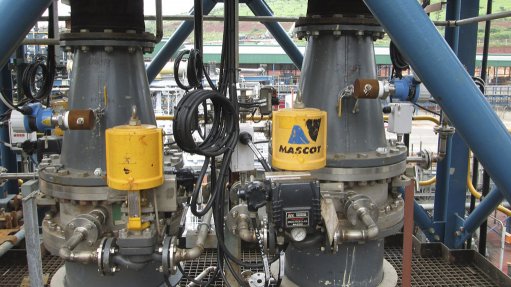
RAMP UP The separators at Kibali will be ramped up to full sulphides in future
The collaborative paper, titled Kibali Gold Mine sulphide concentrate treatment – understanding the pre-oxidation of sulphide concentrates, was presented by dual-listed miner Barrick Gold’s Kibali gold mine technical manager Dr Thamsanqa Mahlangu at the World Gold 2019 conference held in Perth, Australia.
The paper discusses the extensive analysis of plant data and laboratory testwork conducted by specialised minerals processing technology provider Maelgwyn Mineral Services Africa at the Kibali gold mine, in the Democratic Republic of Congo (DRC). In conclusion, it notes that the equipment supplied by Maelgwyn has helped to support and define a niche operating domain for optimal preoxidation processes.
Maelgwyn Mineral Services applications engineer Solomon Mogashoa represented Maelgwyn at the event.
He adds that the conference was also a good platform to meet and foster new relationships, as it enables the company to present its technology to captains of industry.
“I also took note of . . . that the world of digitisation and digitalisation is gaining a lot of traction in gold mining and this was discussed at length during the conference.”
Mogashoa adds, however, that it will take some time before digitalisation can be rolled out on the African continent to the fullest extent, as the infrastructure needed to ensure that remote automation and operation are successful is not yet viable in an African context.
Additionally, the paper suggests that although no single solution is perfect for all mines and ores, the Maelgwyn Aachen oxidisation technology offers enhanced optimisation on site and greater reagent savings and product recovery.
Maelgwyn gold process and environment manager Peter Lotz explains that Aachen reactor technology achieves efficient high-level oxygen mass transfer, along with shear exposure. Slurry is pumped from the process tank through the reactors, where the oxygen is introduced under pressure at high shear and high velocity in a specially engineered aerator system.
Notably high shear equipment relying on pressurised high velocity slurry flows is subject to significant wear and erosion from a combination of abrasion and chemically aggressive environment.
The Aachen reactor units can be fabricated in several sizes to suit the site-specific flow rate requirements of each client.
“We use Kibali as a reference because there we see the different sulphides that the gold is encapsulated in – obviously from different orebodies and deposits – which, in turn, dictate the best method of processing the gold,” comments Lotz.
A contributing factor to Maelgwyn’s continued success in the DRC is the manner in which Barrick manages its service-level agreement (SLA) suppliers to mitigate any bureaucracies that may arrise. “Without structures to safeguard suppliers, trade in the DRC would be a burden,” emphasises Lotz.
He says that through constant research and development, Kibali will, over the next few months, be ramping up its separation operations to full sulphide treatment.
Since releasing the paper, there has been industry consensus that a full sulphide treatment plant will not only increase output but also mitigate some of the environmental challenges posed by the leaching process.
Maelgwyn has been responsible for Kibali’s full separation flowsheet for over more than eight years and continues to deliver its upgraded mineral processing technology whenever applicable.
“Maelgwyn offers continuous on-site equipment maintenance and metallurgical support to its clients is rated as the key to a partnership of mutual benefit,” says Lotz.
Maelgwyn business development manager Juan van der Merwe suggests that the need to maintain and take on the supply chain of rented equipment has brought about the need for the company to almost double its number of site visits over the past few years.
He concludes that being on the ground helps a company to monitor its technology and ensure its sustainability throughout the contract, and leads to further development of the technology.